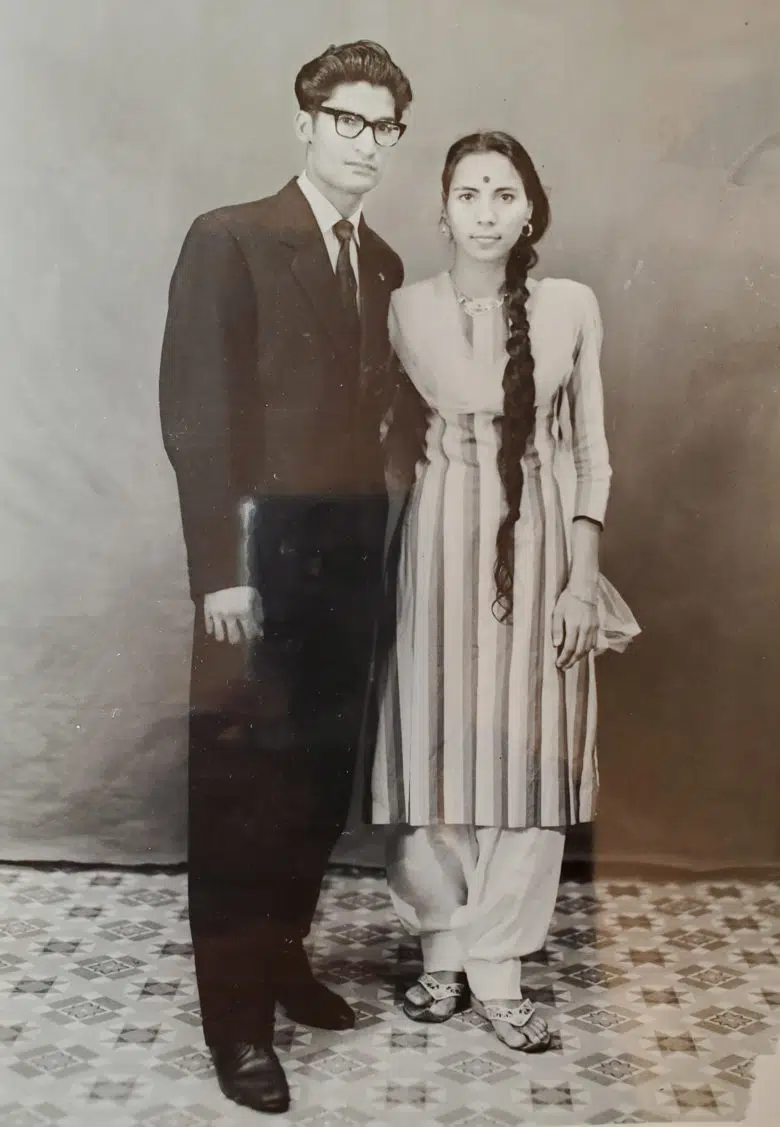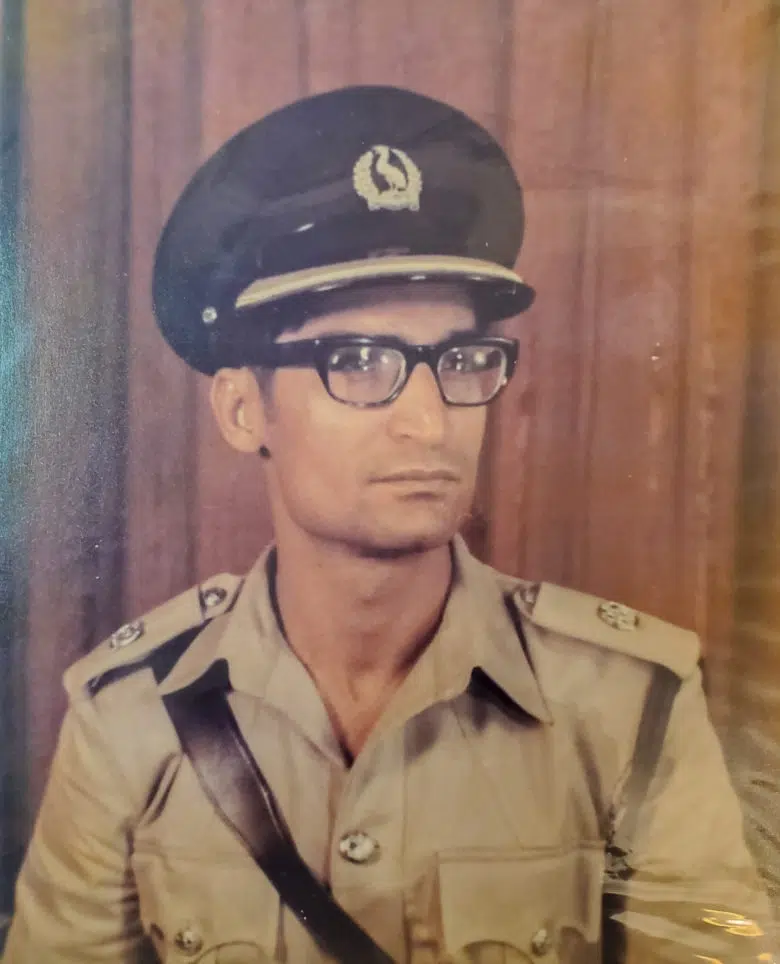‘It was a lucky day for Canada. And a lucky day for us’: Forced to flee Uganda, Saujanis found refuge in Canada
No sound was more welcomed for Rai and Shanta Saujani than the low hum of the aircraft’s engine. As their flight took off from the runway in Entebbe, Uganda, so did the burden that weighed heavy on their shoulders
By Soo-Jung Kim
Photo: © Photo courtesy of the Saujani family
It was September 27th, 1972 — the last time the Saujanis would see the country they once called home.
Fifty years have passed since then, and today the couple is happily retired in Kitchener-Waterloo, Ontario. You couldn’t guess by their positive outlook and sunny disposition the incredible hardships they endured that brought them on their journey to Canada.
This is their story.
The beginning

Rai (left) and Shanta (right) Saujani. © Photo courtesy the Saujani family
“We had built a wonderful life back in Uganda,” the Saujanis recall. Rai was born in Mbale, Uganda and Shanta in Durban, South Africa, but she lived in Uganda for ten years following their marriage.
Rai worked as a deputy superintendent with the Ugandan force in engineering, which provided him with the pathway to obtain his Ugandan citizenship. Shanta was a homemaker, caring for their three kids — a daughter born in South Africa and two sons in Uganda.

Rai Saujani in his police uniform. © Photo courtesy the Saujani family
But in the blink of an eye, everything changed. When Milton Obote’s government was overthrown by General Idi Amin in 1971, things went from bad to worse. Following years of political instability, Amin alleged that South Asians residing in Uganda were sabotaging the country’s economy. He went on to demand the exodus of all Ugandan Asians, with just 90 days to pack up and leave.
“We wanted to stay, even though it was a bad situation… but that was the turning point for us to say let’s get out of here.”
In the lead-up to the expulsion announcement on August 4th, 1972, the Saujanis had sensed something was very wrong. With a solemn expression, Rai remembers, “You could see the dead bodies floating in the Nile River… we saw Asian bodies in the hospital. We wanted to stay, even though it was a bad situation… but that was the turning point for us to say let’s get out of here.”
When the announcement finally came, Rai was stripped of his Ugandan citizenship and left stateless. His work with the police put an additional target on his back — with three of his brothers arrested by the Ugandan army and taken to be tortured overnight. They spent their last few weeks in Uganda in fear and hiding, unsure of the road that lay ahead of them. “We had no future in this country. So here we were. That’s when we visited the Canadian embassy.”
They waited anxiously for their number to show up in front of the large stand next to the hastily set up embassy building.
Canada’s evolving immigration policy
In 1967, Canada adopted the point system for immigrants — the first of its kind in the world. It was an innovative approach to addressing, in part, some of the deep historical roots of racial discrimination within the nation’s immigration policies. At the time, applicants needed to score 50 out 100 points to be eligible to come to Canada.
With a total of 49 points, the Saujanis were short of just one point. Shanta adds, “So there we were, unsure of what to do. The immigration officer asked if we have any relatives in Canada who can sponsor us. So, we said, ‘Yes, my sister is there.’”
“And here we were standing… what’s going to happen to us now?”
At the immigration office in Hamilton, Ontario, her sister’s income was just shy of roughly $10 to qualify as a sponsor. Luckily, she was reminded by the immigration officer of the baby bonus that cleared the sponsorship through.
“So that was it. We are going. Fortunately, we got stamped to go on the first flight. And here we were standing… what’s going to happen to us now?”
“In the end, nothing [mattered] more than we were safe.”
With their three kids in tow, the Saujanis were among the 148 individuals to board the first charter flight headed to Montreal, Quebec. When they arrived, it was a cool autumn day. The crispness of the air left an unusual sting in their lungs, not accustomed to such cold climates. They were taken to the Canadian Forces Base Longue-Pointe, just 30 kilometres east of the airport.
Shanta remembers the relief she felt as she got off the plane. “When I tell you, it was heaven. There was no talk of, ‘I left my house, I left my books, I left my car, I left my money.’ In the end, nothing [mattered] more than we were safe.”
The most Canadian welcome
Shanta reflects on her first memory in Canada fondly. After a grueling 30-hour journey with a layover in Paris, exhaustion had set in. Spread around the room, there were eleven television sets. Shanta recalls shuffling through the queues, akin to what zombies look like, when suddenly, “The immigration officers just threw their pencils and everything up. They started jumping up and down, shouting, laughing and hugging each other… [They looked at us and said,] ‘What’s wrong with these aliens? How come they’re not laughing?’”
It wasn’t until later they realized they had just watched Paul Henderson score the winning goal of the 1972 Canada-Soviet Hockey Summit Series.
“It was a lucky day for Canada. And a lucky day for us.”
Thinking back, “We’ve never seen a puck before, we’ve never seen snow, we never wore [snowpants], we had our traditional clothes… It was a lucky day for Canada. And a lucky day for us.”
The start of a new chapter
It was Friday night, just two days after arriving from Uganda, when the Saujanis departed for Hamilton, Ontario. By Monday, after responding to an ad in the Hamilton Spectator, Rai had already started working as an electronic technician. However, this wasn’t the case for a lot of Ugandan Asians. Many faced barriers when it came to obtaining Canadian experience required for professional accreditation.
The pair reminisced about the odd jobs they worked to make ends meet, like the time their children delivered the Globe and Mail and how their son had used his pocket money to purchase his first bicycle. Or renting out the basement in their home.
When fall turned to winter, Shanta remembers, “I stood by the window…quietly watching the snowflakes coming down. So quiet, so peaceful, so serene. The whole road was white. And this kind of calmness, peacefulness… it was a lovely, lovely sight… I hadn’t seen actual snow.”
She recalls her family’s first Christmas, and how their neighbours in Hamilton had invited them over on Christmas and New Year’s Eve. Or the time their bus driver insisted on a second lap around their neighbourhood to see all the Christmas lights in the city.
Fifty years later
In the 1970s, the racial makeup of Canada was starkly different from the diversity we see today. With racial and national exclusions that dominated Canadian immigration policies from the mid-1800s to the post-war period, the acceptance of Ugandan Asians was a major turning point in the country’s history.
Shanta recalls some of the barriers she and her family faced in finding housing and employment, including verbal harassment, telling her children, “Our skin is brown. We have to work very hard.” Rai went on to complete further education in Waterloo and the couple started their own businesses.
When asked about her reflections on Canada 50 years later, she says, “Canada is a great country. There are good people. Some had negative feelings, but you overlook that. For us, it was heaven and paradise. We were in misery and turmoil. You know how refugee situations are all over the world. So that’s it. It’s a beautiful country.”


